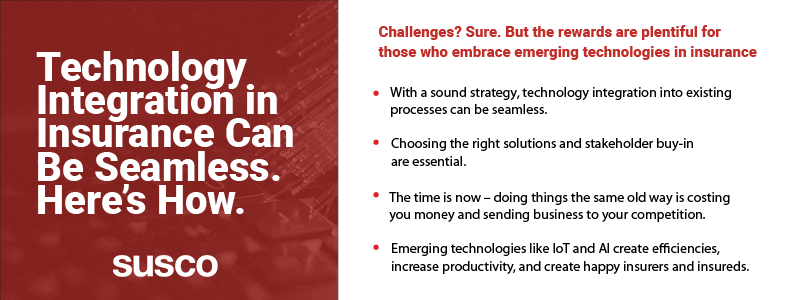Challenges? Sure. But the rewards are plentiful for those who embrace emerging technologies in insurance

There’s no question that insurance adjusting firms must embrace and implement digital transformation. However, the attachment to legacy systems and “the way things have always been done” has created a reluctance to move forward.
This is despite the many advantages of digitization, including significant growth opportunities, operational efficiencies, and increased customer satisfaction. The trepidation stems from integration challenges: will new technology seamlessly blend with my current system? What happens to all of my existing data? Will employees struggle with adoption?
It would be foolish to deny the challenges of technology integration in insurance, but even more so to remain in the technological dark ages while competitors embrace the digital revolution. Challenges exist, yet an effective strategy and selecting the right vendor can break down barriers to seamless technology adoption. Here’s how.
Key technologies and their impact on insurance adjusting
When a customer calls, the complex process of adjusting begins with damage evaluation and interviews with witnesses or claimants. Police and medical reports must be reviewed, as well as the policy. Calculations must be made. Add differing insurance company adjusting guidelines, and reliance on reams of paper, spreadsheets, and manual processes leads to inefficiencies and the potential for error.
Technology solutions reduce costs while increasing standardization and streamlining manual processes. Some current and emerging technologies in insurance that can transform your business include:
–Video chat: The pandemic accelerated the use of video chat, offering real-time data and visual information that can provide early clues regarding liability, reduce insurance fraud, and increase customer retention by expediting the process.
–Better analytics: Access to comprehensive historical data aids in forecasting losses during natural disasters and provides insights into previous claim payments.
–Custom mobile apps: These apps enable both the insured and insurers to upload detailed data. Sharing information with the ecosystem speeds up the claims process and enhances customer satisfaction. With a mobile app, insureds can check their claim status and even ask questions without picking up a phone.
–Artificial intelligence (AI) for computer vision: This technology can extract meaningful information from digital images and videos, helping to identify objects and aid decision-making, thereby reducing errors and enhancing efficiency. Using deep learning and neural network techniques, computer vision can understand what it sees, going beyond human vision to catch what might be missed. It analyzes images using algorithms to identify objects and help with decision-making.
In addition, AI also uses algorithms to assess claim severity and complexity. Complex claims can be routed to experienced adjusters, prioritize and categorize claims, and identify problems that need immediate attention. Errors? Greatly reduced. Efficiency? Greatly enhanced.
–Internet of Things (IoT): Smart devices provide access to data such as the time and location of accidents, aiding in fraud reduction and facilitating instant notifications.
–Blockchain technology: Offers a secure, decentralized method for managing transactions and automating claim processing, resulting in faster settlements and fewer disputes.
All of this technology is designed to increase efficiency and productivity, but how does it integrate with your old systems?
Seamless technology integration requires a strategy
As Benjamin Franklin said in 1790, “If you fail to plan, you plan to fail,” a maxim as true today as it was more than 200 years ago. It’s vital to develop a comprehensive plan for technology integration in insurance. The stakes are high; you need a system that works today and scales as your business grows.
- Assess your needs and goals: Determine what problems the technology will solve and ensure alignment with your strategic objectives.
- Evaluate legacy system integration capabilities: Review data architecture, code, and user experience. Consider modernization options if integration isn’t currently feasible. In all likelihood, you’ll need outside expert help to make this determination – one challenge to this step is a lack of documentation.
- Involve all stakeholders: Gather input from users and customers to ensure usability and effectiveness. Transparency and training are essential for successful integration.
- Choose the right vendor: Research and evaluate vendors based on functionality, reliability, scalability, compatibility, security, support, and cost. Choose a vendor with a great reputation, a solid track record, and stellar customer feedback. Ask for references.
Maximize the benefits of technology integration
Successful integration brings all kinds of benefits that add up to an efficiently run, agile, competitive, and successful business for the long term. Errors are reduced, claims initiation becomes more efficient, claims are more accurately settled with enhanced data analysis, and your customers and their customers are happy.
Using this roadmap, you’ll more easily navigate the complexities of technological integration, driving business success.
At Susco, one of our specialties is legacy system conversion. We’ll partner with you to make things faster, better, and stronger than before. We can do full project development or work with your internal teams to reach your goals.
For more than a decade, our dedicated team of web and application developers has built custom solutions that perfectly align with business goals. Discover what we can do for you. Get in touch today so we can schedule your free one-hour assessment.